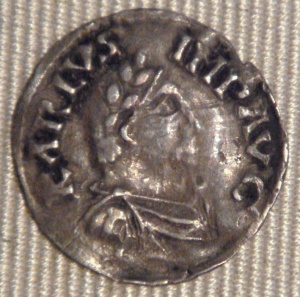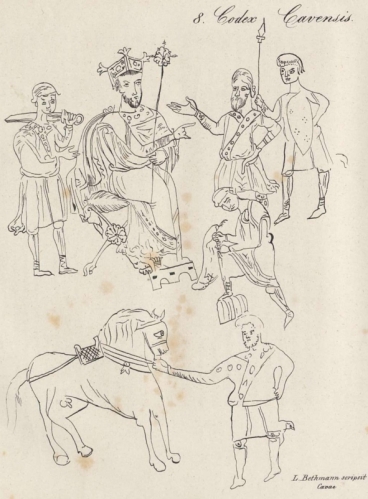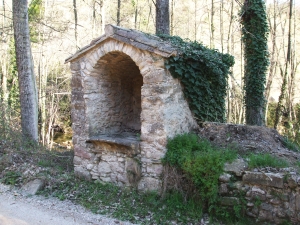Pausing briefly with the photography, let’s drop back in on my more academic self in the latter part of 2018. One might observe that I seem to have spent much of the summer of 2018 abroad, and certainly, I don’t seem to have stubbed many blog posts, which itself suggests that I was not reading very much. An inspection of my Zotero library suggests that actually, what I was mainly doing was clearing up references for the final push on what became my ‘Outgrowing the Dark Ages’, but still, the trail goes faint in June, July and August and I suspect that I was mainly marking or prepping for next year’s teaching.1 I had also picked up again after a long time away – about twenty years in fact – Martin Aurell’s Les Noces du comte, which was to become its own whole big thing that more may be written of at some point, but at this point I was only restarting that. Two things I definitely did read that summer, however, for quite unrelated projects, were Gloria Anzaldúa’s Borderlands / La Frontera and, quite unlike it in every detail except sharing the English language and a paperback format (and, of course, being excellent), Guy Halsall’s Warfare and Society in the Barbarian West.2 And on getting properly into the latter, I stubbed this post mainly to express surprise and delight at two incidental things I found there.
In the template, issued by Charlemagne King of the Franks and his counsellors probably around 793 or 794, for how royal estates should manage their economy and renders, the text we call the Capitulare de Villis, there is so much interesting detail that one can’t take it all in at once.3 I had most recently gone to it looking for what happened to agricultural produce, and so had managed to skip straight over some of the regulations for military provisioning. But of course Guy was looking for the latter, and so he points out quite justly, firstly, that Charlemagne wanted people to send carts to the army from all over the place, which has one contemplating trails of carts wending their way across the various kingdoms towards wherever the muster was each year.4 But, later on, there are further specifications about these carts, namely, that they had not just to be waterproof but be able to float, so that if a river had to be crossed, none of their cargo (which should, for reference, be up to twelve modia of grain) would get wet. Also, each one was to be equipped with a shield, a lance, a javelin and a bow, which as Guy observes is equipment for at least one and maybe two defenders.5 At which rate, these swimmable, hide-covered battle carts stop sounding quite so much like produce wagons and just that bit more like ox-drawn armoured personnel carriers… It had me thinking of some of the odder-looking walker machines in the Star Wars prequel movies, and that storming a Carolingian baggage train might have been a prickly experience, as, presumably, was intended in these laws. Circle the wagons!

This is the kind of thing I had in mind, although obviously made of wood rather than LEGO, with wheels rather than legs, oxen and men rather than mini-figs and weapons other than laser cannons, but come on, share my vision can’t you? Also, I should probably say at this point that I am not getting any money from Amazon for using their images like this, I just think they’re least likely to complain about the free advertising…
Now, I might not have noticed the waterproof castles on wheels that Charlemagne apparently wanted everyone to make, but I did at least register that people were supposed to send carts when I had previously read that text; it did not fall upon me as a complete surprise. Not so much the second thing, dealing with a much earlier episode in a civil war around Comminges. There, the would-be king Gundovald had taken refuge from the pursuing forces of his enthroned rival, and alleged brother, Guntram, and Bishop Gregory of Tours, whose Ten Books of Histories tell us all this, writes from the point of view of the pursuers here:
“In their search for Gundovald they came upon camels and horses, still carrying huge loads of gold and silver, which his men had abandoned along the roads because the animals were exhausted.”
I don’t know about you, but the word that really struck me there was camels. I don’t think of camels as being normal beasts of burden around the Garonne area, even in the sixth century. But Gregory gives no further attention to it and rolls onward with the story (which, at the risk of spoilers, ends badly for Gundovald).6
Now, of course I was not the first person to notice this. I found out a month or two later that Bernard Bachrach notes it in his, er, classic, work Merovingian Military Organisation, but he does nothing with it at all.7 Sam Ottewill-Soulsby, no less, studying diplomacy of three centuries later in which some camels were sent to Charlemagne’s grandson Charles the Bald, emphasises the foreign, eastern resonance they would then have had, indicating Charles’s connections to the mysterious world of the caliphs.8 But does this leave us to suppose that, while a camel was an exotic rarity in the Francia of the ninth century, in the sixth the average king just had troops of them in his baggage train and they were an everyday animal for the time and place? I mean, come back Pirenne if so, right? But I think there might be another explanation.9

An actual medieval French camel picture, or very nearly, from the Château de Chillon in Switzerland
The question to ask is, where had this apparently-much-mocked apparently-pretender Gundovald got these vast quantities of precious metal to abandon anyway? And the answer may be in the next chapter of Gregory’s Histories, where in a set-piece of very useful exposition Gregory has Gundovald answer the taunts of his besiegers with a worked-out explanation of his claim to the throne. In the course of this he explains that, after he was driven out the second time (because yes, his career had been unsuccessful for a while), he’d run off to Constantinople and it was there that Guntram Boso (a duke, not a king, no relation to King Guntram, and the real target of Gregory’s rhetoric here) had sought him out to say, more or less, “all the other claimants are dead, come back and get what’s yours”. And Gundovald had then returned, under a safe-conduct which he now, not unreasonably, felt had been broken.10 But to my mind, when the Roman Emperor sends you west to try for your brother’s throne, especially when your brother’s kingdom is one the Romans were fighting in the Alps only twenty years before and which still threatens imperial possessions, he probably sends you with some gear. The Byzantine strategy of paying people to start civil wars with their enemies rather than risk their own forces was not new at this point, and would get much older, but it makes perfect sense here.11 In short, I suspect that much of Gundovald’s pay-chest and, therefore, quite possibly the baggage train that carried it, had come from Constantinople, which at this point still had control of almost all the lands which Caliph Muhammad would in 865. Emperor Justin II, in short, could have laid his hands on some camels (as it were). He could likewise then have sent them west laden with bullion or coin with which, with a bit of luck, this enterprising young Frank would embroil the Frankish kingdom in civil war for a good few years and leave the empire free to handle the increasingly bad situation in the Balkans. Sam is probably right that sending camels had a special valence, even in 585, but it would not then have been connection to the world of Islam, since that had not yet been created, but to the distant, but also quite close-by, Empire in whose erstwhile territory this was all being fought out. Gregory makes Gundovald look ridiculous, and perhaps he was, but by marching with camels and showering people with solidi he was probably supposed to look a good deal more serious and better connected than the Frankish bishop’s character assassination has let him be remembered.

Perhaps the more powerful tool in Gundovald’s armoury, a gold solidus of Emperor Justin II struck at Constantinople in 565-585 CE, Birmingham, Barber Institute of Fine Arts, B1131
All the same, Gregory apparently did not think his audience would need it explained what a camel was (though to be fair, neither did the annalist in 865). This is not like the single elephant sent to Charlemagne that Sam has also studied, or the occasional lions sent westwards or northwards in diplomacy, which occasioned wonder from most writers dealing with them; a camel was a known thing in this world.12 (And after all, what do we suppose happened to the camels of Gundovald’s baggage train? I doubt they got eaten; too useful! Perhaps there were generations of subsequent Garonne camels. I’m just waiting for the zooarchaeologists to find one now, it’d look ever so global…) We might, as with some other phenomena this blog has looked at, once again need that word we don’t have which means something that was conceptually normal but hardly ever happened. Such a thing, I suggest, was the sixth-century camel in Francia. It’s not by any means all I learnt from Guy’s book; but for the rest, you’ll have to wait for the article…
1. Of course I never miss a chance to reference my own work, and this time it’s Jonathan Jarrett, “Outgrowing the Dark Ages: agrarian productivity in Carolingian Europe re-evaluated” in Agricultural History Review Vol. 67 (Reading 2019), pp. 1–28.
2. Referring to, in sequence, Martin Aurell, Les noces du comte : mariage et pouvoir en Catalogne (785-1213), Histoire ancienne et médiévale 32 (Paris 1995); Gloria Anzaldúa, Borderlands / la Frontera: the new Mestiza, 4th ed. (San Francisco 2012); and Guy Halsall, Warfare and Society in the Barbaian West, 450-900 (London 2003).
3. It’s translated and explained at the link given, but if you need a critical edition (and indeed a facsimile , whose odd shape governs that of the whole book), then it’s Carl-Richard Bruhl (ed.), Capitulare de villis: cod. guelf. 254 Helmst. der Herzog August Bibliothek Wolfenbüttel, Dokumente zur deutschen Geschichte in Faksimiles, Reihe 1: Mittelalter 1 (Stuttgart 1971), and for scholarship see recently Darryl Campbell, “The Capitulare de Villis, the Brevium exempla, and the Carolingian court at Aachen” in Early Medieval Europe Vol. 18 (Oxford 2010), pp. 243–264.
4. Halsall, Warfare and Society, pp. 149-150 n. 97 citing Capitulare de villis cap. 30, where indeed you can see it yourself.
5. Ibid. but now looking at cap. 64, which is here.
6. Here quoting Gregory of Tours, History of the Franks, transl. Lewis Thorpe (Harmondsworth 1974), VII.35, though Guy of course cites the Latin (at Warfare and Society, p. 151 n. 111), which you can see here; the relevant Latin word is camellos, which seems hard to misinterpret.
7. Bernard S. Bachrach, Merovingian Military Organization, 481-751 (Minneapolis MI 1972), p. 58.
8. Samuel Ottewill-Soulsby, “The Camels of Charles the Bald” in Medieval Encounters Vol. 25 (Vienna 2019), pp. 263–292.
9. I cannot find that I have references to what I’m about to suggest anywhere, so I may have thought of it. However, something scratches in my brain when I try that idea, some sense that I have heard or seen parts of this before, and if I have, it may have been either (perhaps most likely) from talking to Sam Ottewill-Soulsby; possibly, from reading Bernard S. Bachrach, “Animals and Warfare in Early Medieval Europe” in Bachrach, Armies and Politics in the Early Medieval West, Collected Studies 405 (Aldershot 1993), chapter XVII, which I have done but where my notes don’t go into this kind of detail; or, longest shot, from a Kalamazoo paper of really long ago, Benjamin Wheaton, “Reasons for Byzantine Support of Gundovald through 584 C. E.”, 46th International Congress on Medieval Studies, West Michigan University, Kalamazoo, 14th May 2011, which I would tell you otherwise I remembered nothing of but which must have covered this material. If what I go on to say has been accidentally ripped off from any of these, or indeed someone else, I apologise…
10. Gregory, History, VII.36.
11. On the general practice, see Evangelos Chrysos, “Byzantine Diplomacy, A.D. 300–800: means and ends” in Jonathan Shepard & Simon Franklin (edd.), Byzantine Diplomacy: papers from the Twenty-fourth Spring Symposium of Byzantine Studies, Cambridge, March 1990 (Aldershot 1992), pp. 23–39, but for the specific context here, even though it doesn’t mention camels, still really good is Walter Goffart, “Rome, Constantinople, and the Barbarians” in American Historical Review Vol. 86 (Washington DC 1981), pp. 275–306, on JSTOR here.
12. On East-West diplomatic gifts of this period, you must expect me naturally to cite Samuel Ottewill-Soulsby, “Carolingian Diplomacy with the Islamic World” (Ph.D. thesis, Cambridge University, Cambridge, 2017), or his marginally more accessible idem, “Carolingian Diplomacy”, in Gordon Martel (ed.), Encyclopedia of Diplomacy (Oxford 2018), DOI: 10.1002/9781118885154.dipl0042, so now I have.































